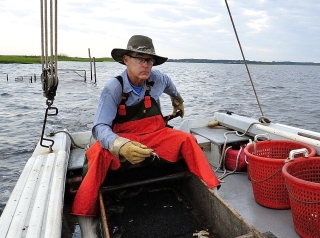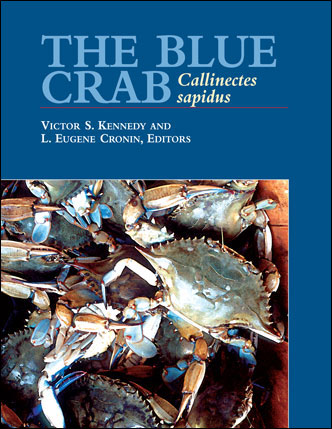Knauss legislative fellowships in Congress help build careers — and they're fun and educational. See our video and fact sheet for details.
A Passion for Peelers
Bank trapping for peeler crabs still goes on in the lower end of Maryland's Eastern Shore. Down in Somerset County watermen like John Barnette can set out traps along sparsely populated stretches of rivers like the Wicomico, the Manokin, the Big Annemessex and the Little Annemessex.
When blue crabs want to shed their old shells they usually head for a nearby shore seeking shelter. But along the south side of the lower Wicomico, they are likely to end up in one of the traps that Barnette sets out every spring along the quiet banks of this wide, marsh-lined river.
When Barnette wants to make money, he will skim his 17-foot skiff along the green marshes, then throttle down, and glide up to each one of his tall cages. After tying off his skiff, Barnette winches each trap off the bottom and perches it on the port-side edge of his skiff, right above his culling box.
.jpg)
A decent haul gets this day started well: more than two dozen blue crabs are scrambling around the cage, wondering where in the world they're headed.
A waterman's world, at least for John Barnette, includes bank traps for catching peeler crabs and bottom leases for growing oysters.
Hanging on. Not all the peeler crabs are ready to exit this strange, cage-like world they've only recently entered. With their claws and fins they can hook themselves hard to the walls of the trap, but Barnette with his heavy bite-proof glove is there to lend a helping hand.
Breaking up is hard to do: Before he can start sorting and measuring them, Barnette has to untangle five fairly surly crabs who have hooked on to each other.
Sizing by eye usually works, but sometimes it takes a measuring stick. The size limit for male peelers changes during the season. Before July 14, legal size is 3-1/4 inches. For the rest of the season, it increases to 3-1/2 inches. For females the size is 3-1/2 for the entire season.
A solitary job, bank trapping for blue crabs leaves plenty of time for a thoughtful man to ponder his life and his work and his world. "It’s been said and it’s been written that no greater thing can a man have than be happy in his toil," says Barnette. "Well, I’m happy in my toil. Few jobs can you get up and go to work every morning and an eagle meets you at your job."
.jpg)
On his daily rounds, the bank trapper has the regular company of like-minded loners like these. "The birds that are around me mostly are solitary birds: great blue herons, the osprey, the eagle," says Barnette. They meet him at his traps because they know he'll probably feed them whatever fish he happens to find in his trap.
Reading time: A bank trapper has to read the weather, the wind, the water, but most importantly he has to read each and every blue crab he catches in order to figure out how soon it's going to shed its shell. To "read" a peeler crab, Barnette eyeballs the edge of the swimming fin searching for a sign, in this case the faint outline of the new skin that is forming underneath the old. A white sign indicates a crab is a week or two from molt. A pink sign says the molt is less than a week away. A red sign warns that molting is coming in two or three days. A "rank" crab is only hours away.
Cracking down:. A trapper not only has to read each crab for "sign" but he also has to disarm it. He quickly cracks the pincer claws, a crab's attack weapons, a trick that renders the crab less lethal to other crabs. This peeler, once it morphs into a soft shell, should bring in $3 down at Handy's Seafood in Crisfield.
The cycle of life: A trapper tosses a $3-dollar, "red sign" peeler crab into the "red sign" basket. And in the background behind his boat, a heron flies off with the fish the trapper left for him.
30 traps a day. Six days a week. Every week between May and September. The morning clears, the weather warms, and the crabber sheds his own shell, his red waders that get too hot under a high sun.
The view from the boat: "Any watermen you talk to who’s been doing it for a while will tell you they like what they do." says Barnette. "If you didn’t, you wouldn’t last long at it. There’s days the job really sucks, there’s days I wouldn’t have anything else."
He can see his day is far from done. Back in his shedding barn, he has to sort his crabs three times a day, keeping the "white sign" crabs away from the "pink sign" and the "pink sign" away from the "red sign." Then he packs his soft shells in boxes, stores them in his cooler, and on four days each week he trucks them down to Crisfield to sell.
_________________________________________
(Our earlier blog post, "Prepping for Peeler Crabs," explains how a bank trapper prepares for the harvest season.)
See all posts from the On the Bay blog







